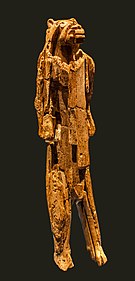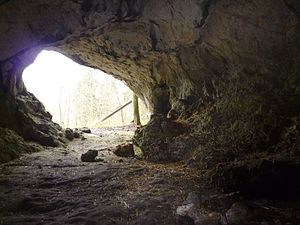Hohlenstein-Stadel (arula)
|
Hohlenstein-Stadel arula, tigisa koe Schwäbische Alb jakama getalte Germana, tir ayaf is abdiizvugalaf debak ke Lekeraporugal. Rawopaf debakbetaraTaneafa jowara isu vestara va Hohlenstein-Stadel arula bak 1861 az 1866 gan Oskar Fraas abdiizvopik zo skud. Hohlenstein-Stadel betsa tir ke glupafa belca dem levedafa betsava is buta. Kolanixo lentlyon vodjuso va vansara va arula nover. Betsava tir ton mantamafa lupaxa dem abrotce vas 50 m-. Tir dem plor is remak kene kot kril. Fulteyafa bada ke Hohlenstein-Stadel arula va men koafizayana muka isu xa ape ruldad. Rawopafa olkotca trasiyina koe bata arula, don kudjot va krapolik, tid evlon gu Moustier Sare iku Madeleine. Nesida ke Aurignac Sare ke arula gu 35000 ik 41000 AR tanda zo evlayar. Tamavafa GadakiewegabetaraBelca dem tevoya abdiizvugalafa arula ( don Hohlenstein-Stadel arula ) milvemon tigisa getalte Germana va tano katcalapafo izvaxo ke tawava tadler nume bak 2007 wetce arayaf debak ke tamavafa gadakiewega ke UNESCO zo bendeyer.
Dere rupecbetara |
| |||||||||||||||||||||||||||||||||||||||||||||||||||||||||
Vuestexa
betara
- (en) Fiona Coward is Robert Hosfield is Matt Pope is Francis Wenban-Smith, The Early Upper Paleolitic and the art of Central Europe, Settlement, Society and Cognition, ed. Human Evolution , Cambridge University Press, 2015, 448 p. [1]
- (en) Michael Bolus, The Swabian Jura, History of Research and the Aurignacian of the Sites in the Swabian Jura, Nuria Sanz, Human origin sites and the World Heritage Convention in Eurasia, ed. UNESCO, vol. n° 41, 2015, p. 166 [2]
- (en) Timothy Insoll, The Oxford Handbook of Prehistoric Figurines [3]
- (en) Andreas Taller is Michael Bolus is Nicholas J. Conard, The Magdalenian of Hohle Fels Cave and the Resettlement of the Swabian Jura after the LGM, Modes de contacts et de déplacements au paléolithique eurasiatique, Actes du Colloque international de l'UISPP, Université de Liège, 28–31/05/2012, coll. « Erault et Archéologiques », 2014, ISBN 978-2-87985-305-5 [4]
- (de) Claus-Joachim Kind, Neue Funde aus der Stadelhöhle im Hohlenstein bei Asselfingen, 2010, Archäologische Ausgrabungen in BadenWürttemberg [5]
- (de) Oscar Fraas, Der Hohlenstein und der Höhlenbär, Jahreshefte des Vereins für vaterländische Naturkunde in Württemberg, vol. 18, 1862 [6]
- (en) Solange Rigaud is Marian Vanhaeren is Alain Queffelec, The way we wear makes the difference, residueanalysis applied to Mesolithic personal ornaments from Hohlenstein-Stadel (Germany), Journal of Archaeological and Anthropological Sciences, Springer, 2013, DOI 10.1007/s12520-013-0169-9, [7]
- (de) Wilfried Rosendahl, Pleistozäne Hominidenreste aus Höhlen Südwestdeutschlands, Arge Grabenstetten Jahresheft, 1996 [8]
- (en) Claus-Joachim Kind is Nicole Ebinger-Rist is Sibylle Wolf, The Smile of the Lion Man. Recent Excavations in Stadel Cave (Baden-Württemberg, south-western Germany) and the Restoration of the Famous Upper Palaeolithic Figurine, Quartär vol. 6, 2014, DOI 10.7485/QU61_07 [9]
- (de) Claus-Joachim Kind, Löwenmensch, Mammut und eine Frau Die älteste Kunst der Menschheit auf der Schwäbischen Alb und die Nachgrabungen am Hohlenstein im Lonetal, 2011, [10]
- (en) Thomas A. Dawson is Jonas Porr, Special objects - Special creatures | sous-titre chapitre = Shamanistic Imagery and the Aurignacian art of Southwest Germany, The Archaeology of Shamanism, Routledge, 2003, [11]
- (de) Nicholas J. Conard is Michael Bolus is Ewa Dutkiewicz, Eiszeitarchäologie auf der Schwäbischen Alb. Die Fundstellen im Ach- und Lonetal und deren Umgebung, Kerns Verlag, Tübingen, 2015, ISBN 978-3-935751-24-7 [12]
- (de) Stephan M. Heidenreich is Conny Meister, UNESCO Welterbe Höhlen und Eiszeitkunst der Schwäbischen Alb, Land Baden-Württemberg, Landesamt für Denkmalpflege, 2017 [13]
- (de) Joachim Hahn, Kraft und Aggression, die Botschaft der Eiszeitkunst im Aurignacien Süddeutschlands ?, Archaeologica Venatoria, Institut für Urgeschichte der Universität Tübingen, 1986
- (de) Robert Wetzel, Quartärforschung im Lonetal, Quaternary, Tübingen, 1954 [14]
- (de) Eberhard Wagner, Höhlen als archäologische Denkmäler, Denkmalpflege in Baden-Württemberg, 1983 [15]
- (de) Robert Wetzel, Der Hohlestein im Lonetal, Dokumente alteuropäischer Kulturen vom Eiszeitalter bis zur Völkerwanderung, Mitteilungen des Vereins für Naturwissenschaft und Mathematik in Ulm, vol. 26, 1961 [16]







